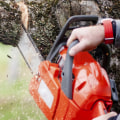Signs of an Unhealthy TreeCavities, cracks and holes in the trunk or limbs, wilting, bare patches, broken branches, leafless branches, abnormal color, shape and size of leaves, holes in leaves, visible insects or evidence of insects. Although it is not a direct symptom in the tree itself, if there are cracks in the mud around the base of the tree or if some of the soil has risen, it is possible that the tree has started to uproot. Check carefully for more cracks on one side, as this could mean that your tree is starting to tilt.
Integrity Tree Care
5304 Carol Ave Indian Trail, NC 28079. If your maintenance practices are top notch, poor tree health can be caused by insects or diseases.Warning signs of any of the invaders include visible insects, lack of fruit or flowers on a fruit tree, distortion in leaves, holes in bark, irregular growth on branches, and sap oozing on evergreen trees. Just by looking closely at the structure of a tree, you can often determine its level of health. Start by evaluating the trunk and branches. Is the tree missing sections of bark? Are there deep cracks in tree branches? Both are visible signs that a tree is not healthy.
Whether the cause is poor weather, ineffective pruning, or disease of a tree, a sick tree will often show signs outside. Dead or dying branches that hang low, lack bark and have no leaves. You may be able to prop up the tree to prevent it from falling completely, but don't expect that to save it. From Ohio he asked: “There is a tree in my backyard that looks sick (leaves stained and yellowed) and at least one branch is completely dead.
Jeshua, from British Columbia, wondered, “I have a sick pine tree and I need help to keep it healthy. If nothing else, it will certainly reassure you when the next storm arrives knowing that a professional has evaluated your tree for possible hazards. That said, unless you're familiar with trees, it can be difficult to recognize the symptoms of an unhealthy tree before it's too late. Pests such as bark beetles and carpenter ants live on trees that are under stress or are in the process of dying.
Contacting an arborist as soon as you notice any signs of a dying tree will give you a better chance of saving it. These species include fruit trees such as peach, nectarine, cherry and plum trees, species that contain several trunks (each trunk must have a main leader), and some forms of topiary and bonsai, such as a trellis, that are pruned and trained to adopt a certain growth pattern. Sometimes a dying tree is obvious, with leaves that turn brown in summer or branches riddled with holes from wood-piercing pests. If you see broken branches or twigs on the ground around a tree, you should call a tree specialist to inspect it.
Most landscape trees need to be pruned to have only one central leader (the vertical stem at the top of the trunk). If you notice bleached wood or lighter spots on the bark, the tree may have a root rot disease called armillaria.






